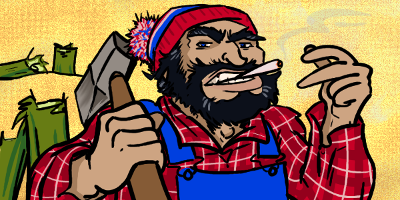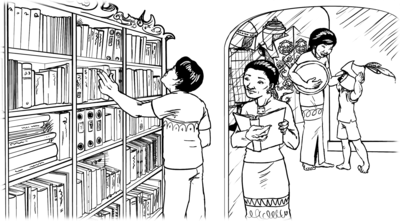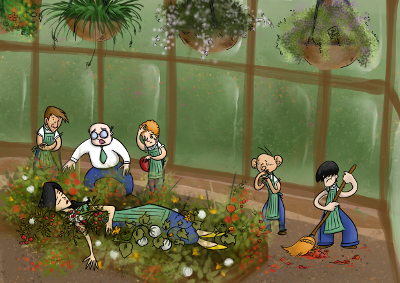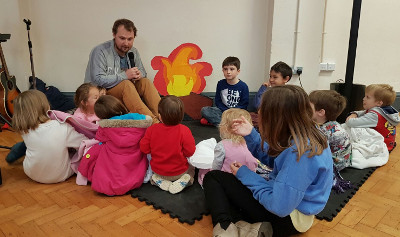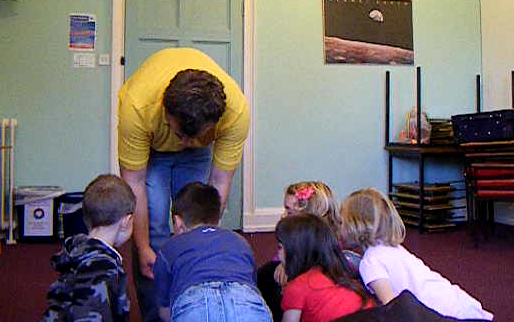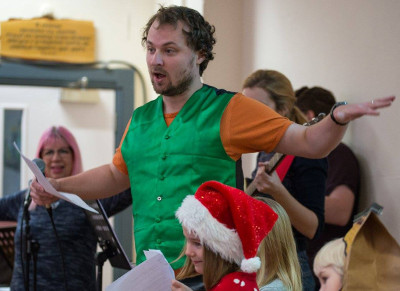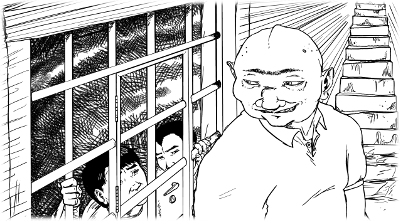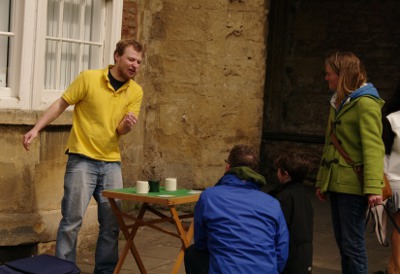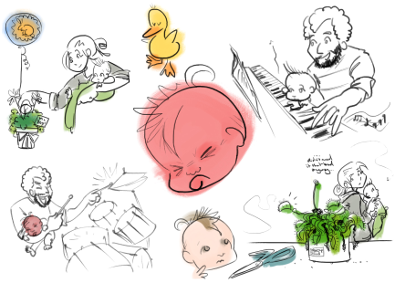Only a Hammer
Each player takes on the Role of a character formed by combining the various Skill,Trait,Role and Goal cards.
The aim of the game is to become the main character of the story by being the first player to complete their Goals.
Key Terms
- Games Master (GM): The player who's job it is to maintain the story.
- Player Character (PC): A Character Controlled by a player.
- Non Player Character (NPC): A Character controlled by the GM. These can be anyone. They may have a short, or long story life span, or may even join the party for a time.
- Goal: What your PC must achieve in order to win the game. These can relate to PCs and NPCs. //TODO
- Bank: Holds all unowned Dice and Tokens.
- Dice Pool: The collection of dice each player has. they can earn more dice, and lose them. Owning more dice allows you more freedom to act as you want.
- Growth Pile: A pile of cards containing all Traits, Skills, and Goals, after the initial set have been distributed.
- Growth Row: A row of 5 face up Traits, Skills or Goals, that can be purchased, this is sourced from the Growth Pile.
- Token: Tokens are counters used to reward players for acting on their Traits and Skills. Using Traits and Skills earns you Tokens, which either count as Victory Points, or can be traded to buy new Growth Cards.
- Coerse: Make a player do what you want by giving them dice. See "Coersion
Equipment
- Cards : There are 6 different kinds of Cards.
- Scenario - Provide starting conditions for the game.
- Event - External events to move the story forward.
- Role - Character name and brief description
- Goal - What your character must achieve to be successful.
- Trait - Characteristics of the player that will effect how they behave.
- Skill - Abilities a character has, that can be used in the story.
- Many Dice
- Many Tokens
Setup
Separate the Cards into their various types. Shuffle them separately, and deal the following to each player.
* 1 Role Card
* 2 Goal Cards : 1 Face up, 1 Face down.
* 3 Trait Cards
* 3 Skill Cards
With the exception of the face down Goal Card, all cards should be face up and publicly visible.
The player is not allowed to show his Secret Goal Card to anyone. He may tell them what it says, and he may lie about it, but he must not show it to anybody.
Give each player 8 dice.
Shuffle the Goal, Trait, and Skill Cards together. Place them in a pile in the middle of the table, this is the Growth Pile. Draw the top 5 cards from the Growth Pile, and place them face up in a row. So that everyone can see all 5 cards, this is the Growth Row.
Core Mechanic : Bidding
This Game does not have a single GM, instead players bid to become GM for a short period.
Each player has a number of dice in their pool. To Bid for something, each player may choose any number of those dice, and put them in their closed hand secretly ready to bid, while hiding the rest of the dice.
Once each player has chosen a number of dice, they place their closed hand in the middle. Once everyone has done this, reveal together how many dice each of you have chosen.
Then everybody rolls their bid dice.
The player with the highest total becomes GM for the next period. The dice he bid are returned to the bank.
Everyone else keeps their dice and returns them to their own pool.
- In the case of a tie, the tied players roll again.
- If all players choose to bid zero dice, then all players that have any dice, must roll 1.
- In the unlikely event that no-one has any dice, all players recieve one dice from the bank.
Order of play
Initial play
The following set of actions enable the set up of the characters and story.
- Each player reads out their Role cards, and gives any extra info they want to.
- Draw a Scenario Card.
- Players Bid for GM
- The new GM provides a background for the scenario based on the Scenario card. They must answer the questions on the card, and may provide whatever other details they wish to.
- The GM then asks each player questions to find out about their character.
- Who they are
- Why they are at the scene
- What they are good at
- How they understand their goal, providing specifics.
- The GM Provides the same information about their own character.
Normal play
The following series of actions repeats to the end of the game.
- The GM asks if any player has anything they want to do.
-
- If any players say yes, the GM asks each player in the order of their choice, what the players do
- If all players say no, the GM Draws an Event Card.
- Players bid for GM
- The new GM either fills in the details of the Event, or combines the players chosen actions into a cohesive event, adding any twists they want. See Resolving Actions below.
Resolving Actions
The primary job of the GM is to bring everything the characters choose to do together into a complete series of events.
The GM must take every player's choices into account, and they may ask pointed questions to get more specifics, however they do not have to let everything succeed.
If they say any characters action fails, they must give them 1 dice from the bank. If they say that the characters action fails drastically, they must give them 1 dice from their own hand.
If the character has a relevant Skill or Trait that would make them likely to succeed, make that 2. For every three tokens on that Skill or Trait, increase that number by one.
Note: If you do not have the needed dice, you cannot create a drastic fail.
If the character has a trait that would make them likely to fail, or that can be used to create trouble, feel free to use it. That player recieves a token on their trait, and the GM also recieves a dice.
If the GM resolves the actions in a way that causes trouble for themselves, or makes their own public goal harder to achieve they may receive two extra dice from the bank.
Earning Tokens and Dice
Tokens can be used to establish strength in certain Skills. If a player has 3 Tokens on a Skill, they are said to be an expert, if they have 6, then they are a Master.
Every time a character uses a Skill they have, the player recieves a Token, and places it on that Skill Card.
Every time a character acts in accordance with a Trait they have, they recieve a Token and place it on that Trait Card. They also recieve 1 more dice from the Bank.
If acting out on that Trait gets them in trouble in any way, they recieve an additional 2 Dice. Tokens may never be moved from one card to another, but they can be paid to the bank to purchase Character Cards
Coersion
Some Skill and Trait Cards have the ability to Coerce other Players into doing something.
This is often worded like this
"Coerce [Player] with [a number of] dice to [action]".
The order of actions is as follows.
-
you physically place [the number of] of your dice into their pool, and say.
"[You do action]". -
They may then accept your dice and do the action.
Or
- They may say no, and give you back your dice, and another dice of their own.
If you use a skill to Coerse a player then you only get a token if they accept.
If you use a trait to Coerse, you do not get points for coercing, only for acting yourself in the manner of your trait.
The Growth Row
The Growth Row is the row of 5 Face up cards that are available for any player to buy, and so become.
When you are asked what your character does, you may choose to buy Skills Traits or Goals from the Growth Row.
In these purchases, dice from your pool are worth 1 point, and tokens from your cards are worth 3 points.
Place whatever dice and tokens you have used in the bank, and take the card. Replace it in the trade row with the top card from the draw pile.
You may instead choose to purchase the top card on the draw pile. Pay 6 points to buy it publicly and place it face up with the rest of your cards, or pay 9 points to buy it secretly, and place it face down. You may look at it.
In order to use the card you must reveal it, but you may wait until the last moment. If an opportunity arrises you can use this card unexpectedly.
If you buy it publicly or when you reveal it, you must explain how to everyone how you came across this Skill/Trait or Goal.
Goals
If you have bought a new Goal, you must drop a previous Goal, either your secret Goal or the public one. You must also explain to the group why your character does this.
Ending the Game
The Happy ending
When a player believes he has achieved both of his Goals, both public and secret, he may try to declare himself the victor.
If he can convicingly persuade the group he has achieved his public Goal, then he may reveal his secret Goal, and explain why he has achieved this. If the group is convinced everyone plays two more rounds of actions with the aim of concluding their own stories. Then go to Scoring.
If the group is not convinced, then his secret Goal is now revealed, he must pay 6 dice (or all of his dice and a token). Both his goals are now public.
The Satisfactory Ending.
The game ends when any of the following happen:
- All Event Cards have been played, and no-one else has anything to add.
- One player collects 21 Tokens.
- All players agree to end.
Go to Scoring
Scoring
If a player achieved a Happy Ending, they recieve 25 points for completing their goals.
Each other player reveals their Goal cards, and tries to persuade the group how well they have achieved their Goals. For each Goal, the group must agree on a score from one to 10. If there is any disagreement, then it comes down to an average.
Players also recieve 1 point for every token they have collected.
The player with the highest score wins.
Trouble Shooting
Not enough dice
If you need to give a player a dice from the bank, but the bank is empty because you do not have enough dice. Every player that has dice must give one to the bank. Then the player may take how many he needs.
A Player Character Died
The GM is responsible for letting this happen. He must give up 3 dice and a token to the bank.
The deceased player may choose to begin again. To do this he must :
- Place half of the tokens he has onto the now deceased card. (rounded up).
- Discard all previous trait,skill and goal cards.
- Draw a new Role Card
- Draw Growth Cards from the Growth Pile until he has 2 Goal Cards.
- All non Growth Cards must be laid out face up.
- He may choose which Goal is secret.
- If he has less than 3 Trait or or 3 Skill Cards he may choose them from the Growth Row, until he has enough.
The GM must ask questions, to find out who this new characer is, and how they have come to join this party and what their public goal is.
The party is divided.
If differences in goals lead to the party being split up, then it is OK.
All players stay at the same "table" , The GM may decide which events happen to which party, and manage the reactions of that party while progressing the other party too. It would be a good idea to use circumstances to bring them back together again where possible.
